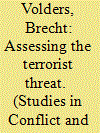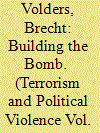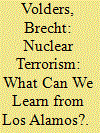| Srl | Item |
| 1 |
ID:
144867


|
|
|
|
|
| Summary/Abstract |
Each terrorist organization faces a critical tradeoff between effectively managing the organization's violent behavior while remaining secure from counterterrorism efforts. Drawing on organization theory and terrorism literature, this article develops theoretical linkages between the organizational design of a terrorist group and this critical tradeoff. It considers the impact of four key design parameters: membership, operational space and time, formalization, and centralization. The first two structural parameters construct the physical anatomy of a terrorist organization. The latter two structuring parameters prescribe or restrict the behavior within this organizational context. Net advantages by means of rising structural design parameter values are increasingly offset by the organizational strength and security vulnerabilities that inherently follow from the rising structuring parameters.
|
|
|
|
|
|
|
|
|
|
|
|
|
|
|
|
| 2 |
ID:
183002


|
|
|
|
|
| Summary/Abstract |
A terrorist organization constructing and detonating a nuclear device is often a topic of popular, academic, and political concern. Yet, assessing this risk is a challenging task. This article aims to contribute to the encompassing nature of any future nuclear terrorism threat assessments by further exploring the often overlooked organizational dimension in probability assessments on nuclear terrorism. Particular emphasis is given to the role of the organizational design. In order to do so, this article theoretically builds on a 2017 research article and empirically studies Aum Shinrikyo’s chemical and biological armament activities. This article confirms and further refines the idea of an effectiveness-efficiency trade-off for a terrorist organization implementing a nuclear armament project. It particularly zooms in on the constraints that follow from the covert nature of this type of plot and elaborates on the role of Aum Shinrikyo’s value-rationality.
|
|
|
|
|
|
|
|
|
|
|
|
|
|
|
|
| 3 |
ID:
169921


|
|
|
|
|
| Summary/Abstract |
The international security community is increasingly concerned about the nexus between indiscriminate terrorism and the proliferation of nuclear technology and materials. Many nuclear terrorism threat assessments focus primarily on terrorist motivations to employ an atomic bomb, the availability of nuclear know-how and technology, and the opportunity for clandestine organisations to acquire fissile material. Scholars and experts, however, often neglect to elaborate on the challenges for terrorist organisations in organising and implementing the construction and detonation of a crude atomic bomb. This will most likely be a complex project. This article will therefore explore the organisation of such an endeavour. To be precise, we will highlight the impact of the organisational design of the terrorist group. The organisational design determines the division of tasks and how coordination is achieved among these tasks. It therefore has a strong impact on the functioning of any organisation, especially an innovative and complex terrorism project. Building on a case study of Los Alamos, we inductively infer that terrorist organisations face an inherent effectiveness-efficiency trade-off in designing a nuclear armament project.
|
|
|
|
|
|
|
|
|
|
|
|
|
|
|
|